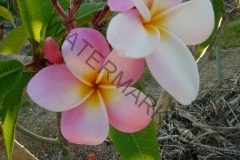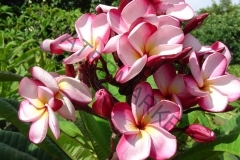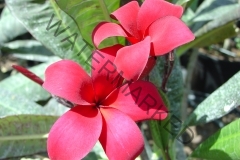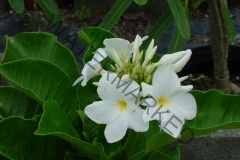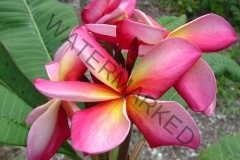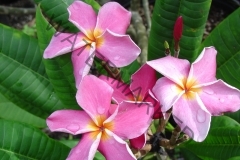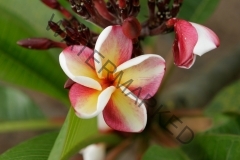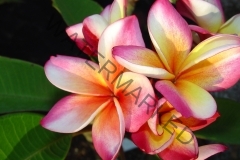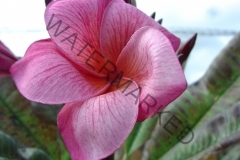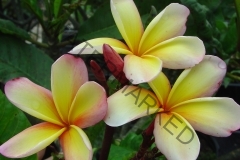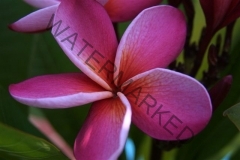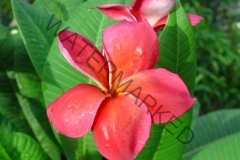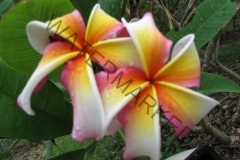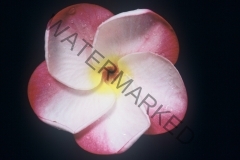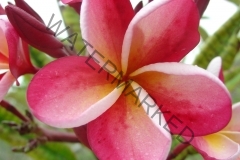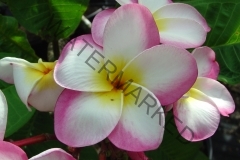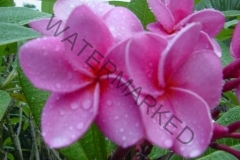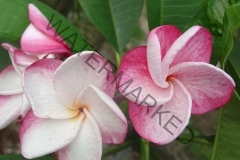The Plumeria and Frangipani Flower: It’s Meanings & Symbolism
Few tropical flowers are as delicate and pure looking as the Plumeria. Also commonly known as frangipani, this flower is native to South America and the Caribbean Islands. Even if you do not live in a climate zone warm enough for growing your own Plumeria outside year around, you can grow them in pots and protect from frost and winter cold. Even if you don’t grow Plumeria you can appreciate the rich scent and inspiring meaning of this bloom. Explore the history and power of this flower to find out how to use it as a potent symbol for personal development or making meaningful arrangements.
What Does the Frangipani Flower Mean?
A few different cultures have assigned meanings to the Frangipani flower, including modern American culture. These meanings include:
- The strength to withstand tough challenges
- Connecting with spirits and ghosts
- Welcoming guests and inviting them to stay, due to its use in Hawaiian leis
- Intense love and a lasting bond between two people
- Immortality and spiritual devotion spread over multiple lifetimes
The Mayans and other Mesoamericans held this flower in very high esteem, as evidenced by the extensive carvings and paintings found that feature the blooms. However, it’s not currently known what exactly the plumeria means to them. The flower is still used today in religious rituals from Hindu, Buddhist, Balinese, and Swahili cultures.
Etymology and Common Names of the Plumeria Flower
All Frangipani varieties fall under the scientific name of Plumeria. The Frangipani title was derived from a 16th century nobleman named Marquis Frangipani. He created an unique perfume that became very popular for scenting gloves, so when the flower arrived in Europe shortly afterwards and produced a scent very similar to his perfume, the name stuck.
The genus is named in honor of the seventeenth-century French botanist Charles Plumier, who traveled to the New World documenting many plant and animal species. The common name “frangipani” comes from a sixteenth-century marquis of the noble family in Italy who claimed to invent a plumeria-scented perfume, but in reality made a synthetic perfume that was said at the time to resemble the odor of the recently discovered flowers. Many English speakers also simply use the generic name “plumeria”.
In Persian, the name is yas or yasmin.In Bengali the name is “Kath Golap”, in Hindi, champa, in Gujarati language, “Champo”, in Marathi chafa, in Telugu deva ganneru (divine nerium), in Meitei khagi leihao. In Hawaii, the name is melia, although common usage is still ‘plumeria’. In Malayalam it is called pāla and chempakam. In Sri Lanka, it is referred to as araliya (අරලිය) and (in English) as the ‘Temple Tree’. In Cantonese, it is known as gaai daan fa or the ‘egg yolk flower’ tree. The name lilawadi (originating from Thai) is found occasionally. In Indonesia, where the flower has been commonly associated with Balinese culture, it is known as kamboja, in Bali especially it is known as jepun. In French Polynesia it is called tipanie or tipanier and tīpani in the Cook Islands. In the Philippines it is called kalachuchi.
Symbolism of the Plumeria Flower
Modern florists often recommend the Plumeria as a gift for someone who has endured many challenges because this plant must be heated over 500 degrees F to catch alight and start burning. Aside from a natural toughness, the delicate look of the flower makes it a symbol of grace, wealth, and perfection across Asia. However, many people in China and Vietnam consider it unlucky because of a folk belief that ghosts and other spirits live in the branches of the bush. As a wedding flower across southern India, it symbolizes the lasting bond between a married couple. Chinese people also use it to indicate affection and love when it’s inappropriate to speak about those feelings openly. Swahili poets also use it as a symbol of love, while Buddhist and Hindu followers consider it a sign of immortality and the continuation of the soul after death.
Plumeria Flower Color Meaning
This plant can produce flowers ranging from pure white to yellow, pink, red, orange, violet and multi-colors (no Blues). Most of them share the same meanings, with the notable exception of the white flower in Indian culture. Red flowers aren’t used for weddings, so only white and cream colored Plumeria are considered appropriate for declaring love between two people.
Meaningful Botanical Characteristics of the Plumeria Flower
The Plumeria is mainly used as a source of perfume oil and for decorating around houses and temples. However, some researchers are using plumeria as potential treatments for a variety of health problems, including cancer and Alzheimer’s disease.
Special Occasions for the Plumeria Flowers
Give the gift of a fragrant Plumeria for:
- Weddings, especially between two very compatible people
- Cheering up a friend after a difficult time
- Honoring the spirits of loved ones
- Reminding yourself of the immortality of the soul
Taxonomy
The genus Plumeria includes more than a dozen accepted species, and one or two dozen open to review, with over a hundred regarded as synonyms.
Plumeria species have a milky latex that, like many other Apocynaceae contains poisonous compounds that irritate the eyes and skin. The various species differently in their leaf shapeand arrangement. The leaves of Plumeria alba are narrow and corrugated, whereas leaves of Plumeria pudica have an elongated shape and glossy, dark-green color. Plumeria pudica is one of the everblooming types with non-deciduous, evergreen leaves. Another species that retains leaves and flowers in winter is Plumeria obtusa; though its common name is “Singapore,” it is originally from Colombia.
Accepted species:
- Plumeria alba – Puerto Rico, Lesser Antilles
- Plumeria clusioides (Synonym of Plumeria obtusa L. – Cuba
- Plumeria cubensis (Synonym of Plumeria obtusa L.) – Cuba
- Plumeria ekmanii (Synonym of Plumeria obtusa L.) – Cuba
- Plumeria emarginata (Synonym of Plumeria obtusa L.) – Cuba
- Plumeria filifolia – Cuba
- Plumeria inodora – Guyana, Colombia, Venezuela (incl Venezuelan islands in Caribbean)
- Plumeria krugii (Synonym of Plumeria obtusa L.) – Puerto Rico
- Plumeria lanataBritton (Synonym of Plumeria obtusa var. sericifolia (C.Wright ex Griseb.) Woodson) – Cuba
- Plumeria magnaZanoni & M.M.Mejía- Dominican Republic
- Plumeria montanaBritton & P.Wilson(now a synonym of Plumeria obtusa L.) – Cuba
- Plumeria obtusa– West Indies including Bahamas; southern Mexico, Belize, Guatemala, Florida; naturalized in China
- Plumeria pudica– Panama, Colombia, Venezuela (incl Venezuelan islands in Caribbean)
- Plumeria rubra– Mexico, Central America, Venezuela; naturalized in China, the Himalayas, West Indies, South America, and numerous oceanic islands
- Plumeria sericifoliaWright ex Griseb.(Demoted to Plumeria obtusa var. sericifolia (C.Wright ex Griseb.) Woodson) – Cuba
- Plumeria × stenopetala
- Plumeria × stenophylla– Mexico and Central America
- Plumeria subsessilisDC.- Hispaniola
- Plumeria trinitensisBritton(Synonym of Plumeria obtusa var. sericifolia (C.Wright ex Griseb.) Woodson) – Cuba
- Plumeria tuberculataLodd.(Synonym of Plumeria obtusa var. sericifolia (C.Wright ex Griseb.) Woodson) – Hispaniola, Bahamas
- Plumeria venosaBritton(Synonym of Plumeria obtusa L.) – Cuba
Formerly included in genus:
- Plumeria ambiguaMüll.Arg. = Himatanthus bracteatus (A.DC.) Woodson
- Plumeria angustifloraSpruce ex Müll.Arg. = Himatanthus attenuatus (Benth.) Woodson
- Plumeria articulataVahl = Himatanthus articulatus (Vahl) Woodson
- Plumeria attenuataBenth = Himatanthus attenuatus (Benth.) Woodson
- Plumeria bracteataDC. = Himatanthus bracteatus (A.DC.) Woodson
- Plumeria drastica = Himatanthus drasticus (Mart.) Plumel
- Plumeria fallaxMüll.Arg. = Himatanthus drasticus (Mart.) Plumel
- Plumeria floribundavar floribunda = Himatanthus articulatus (Vahl) Woodson
- Plumeria floribundaacutifolia Müll.Arg. = Himatanthus bracteatus (A.DC.) Woodson
- Plumeria floribundacalycina Müll.Arg. = Himatanthus bracteatus (A.DC.) Woodson
- Plumeria floribundacrassipes Müll.Arg. = Himatanthus bracteatus (A.DC.) Woodson
- Plumeria hilarianaMüll.Arg.= Himatanthus obovatus (Müll.Arg.) Woodson
- Plumeria lancifoliaMüll.Arg.= Himatanthus bracteatus (A.DC.) Woodson
- Plumeria latifolia= Himatanthus obovatus (Müll.Arg.) Woodson
- Plumeria martiiMüll.Arg.= Himatanthus bracteatus (A.DC.) Woodson
- Plumeria microcalyx= Himatanthus articulatus (Vahl) Woodson
- Plumeria mulongo= Himatanthus attenuatus (Benth.) Woodson
- Plumeria obovataMüll.Arg.= Himatanthus obovatus (Müll.Arg.) Woodson
- Plumeria oligoneuraMalme= Himatanthus obovatus (Müll.Arg.) Woodson
- Plumeria phagedaenica ex Müll.Arg. 1860 not Mart. 1831= Himatanthus drasticus (Mart.) Plumel
- Plumeria phagedaenica 1831 not Benth. ex Müll.Arg. 1860= Himatanthus phagedaenicus(Mart.) Woodson
- Plumeria puberulaMüll.Arg.= Himatanthus obovatus (Müll.Arg.) Woodson
- Plumeria retusa= Tabernaemontana retusa (Lam.) Pichon
- Plumeria revolutaHuber= Himatanthus stenophyllus Plumel
- Plumeria speciosaMüll.Arg.= Himatanthus bracteatus (A.DC.) Woodson
- Plumeria sucuubaSpruce ex Müll.Arg.= Himatanthus articulatus (Vahl) Woodson
- Plumeria tarapotensisSchum. ex Markgr.= Himatanthus tarapotensis (K.Schum. ex Markgr.) Plumel
- Plumeria velutinaMüll.Arg.= Himatanthus obovatus (Müll.Arg.) Woodson
- Plumeria warmingiiMüll.Arg.= Himatanthus obovatus (Müll.Arg.) Woodson
Additional information is available and references are Wikipedia. https://en.wikipedia.org/wiki/Plumeria.
